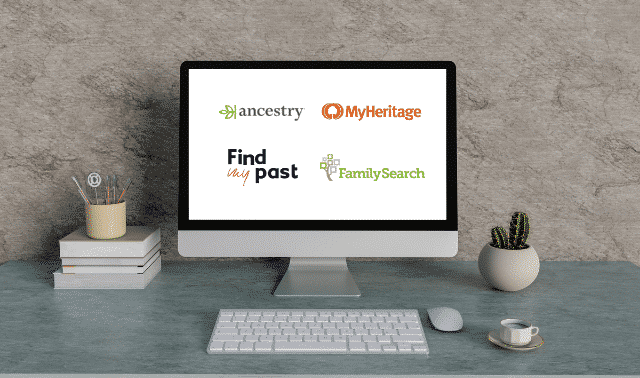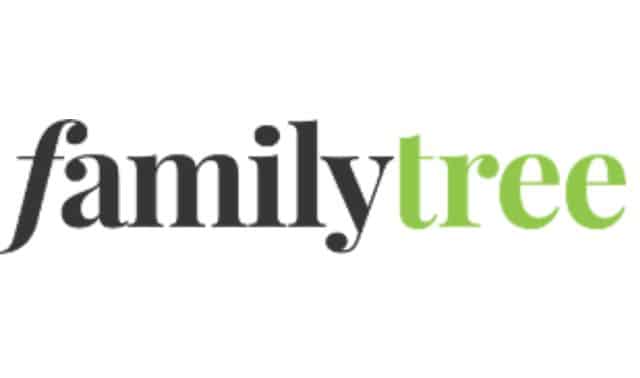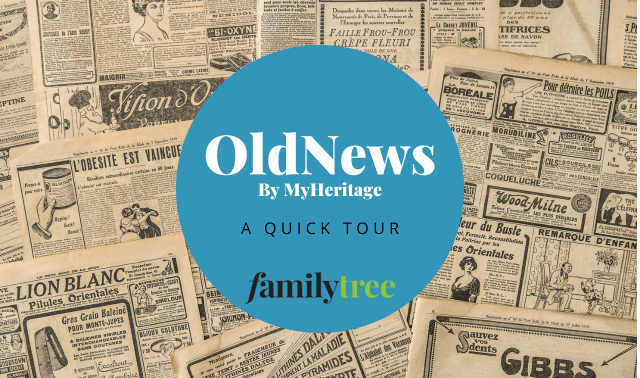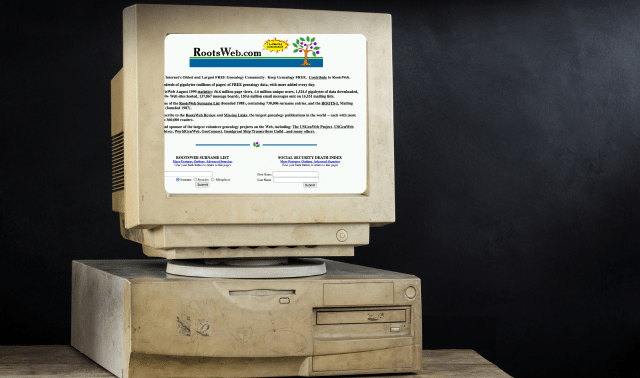Sign up for the Family Tree Newsletter! Plus, you’ll receive our 10 Essential Genealogy Research Forms PDF as a special thank you.
Get Your Free Genealogy Forms
"*" indicates required fields

Findmypast, a UK-based genealogy site, began with a focus on UK and Irish records but has since added large collections for the United States and Canada. The website launched in 2003 as 1837online.com, with vital records indexes for England and Wales. It changed its name to the broader Findmypast in 2006.
In partnership with FamilySearch, it’s creating the web’s largest collection of US marriage records, which eventually will have more than 100 million records and more than 450 million names dating from 1650 to 2010. Through its acquisition of Mocavo, Findmypast added US census records from 1790 to 1940, plus books, pamphlets and periodicals.
You can build your family tree on Findmypast and attach records to it, but you can’t yet search all the site’s family trees.
1. Search all the records
On the home page, you can search on first and last names, an event type (birth, death or other), a year or range of years, and a place. Place options include World, Australia and New Zealand, Ireland, the United Kingdom, or United States and Canada, plus a state, county or city you type. You might start by typing just a surname into the home page search form. If you get too many irrelevant results, click Edit Search on the results page. This form’s fields echo the search form on the home page, and add checkboxes to deselect first and/or last name variants, effectively producing an exact search.
To the left of your results, further narrow your matches by selecting a country, a category (such as Immigration & Travel) or a subcategory (such as Passenger Lists).
My ancestor Evan Powell died in 1819 in Boughrood, Radnorshire, Wales. Search on the name with the year of death and location (select United Kingdom and enter Boughrood in the box), and you get one match. A transcription, created by the Powys Family History Society as part of the National Burial Index, says Evan Powell was buried March 3, 1819, at age 80 at St. Cynog Anglican church in Boughrood. This index has more than 12 million names of people buried in England and Wales between 1452 and 2005 (mostly from 1813 to 1850).
2. Search a record category
To browse all record categories, select Search All Records from the Search tab and select a category or subcategory on the left.
Each category has a customized search form. For example, the census search form lets you enter a house number and street name. To limit your search to a specific census, start typing a year, such as 1850, in the Record Set box or click on Browse Record set, and select an option.
A global search doesn’t produce matches in the Newspapers & Periodicals category, so you need to search it or individual record sets in that category separately.
Try searching the Newspapers records category for a name plus a place of residence or another term closely associated with your relative, such as an occupation or a spouse’s name. My ancestor Samuel Jones, for instance, lived in the parish of Llanigon, Breconshire, Wales, so I clicked on Newspaper records, selected the British newspapers collection and searched on his name plus Llanigon as a keyword. The 18 matches include an article in the Jan. 29, 1806, Hereford Journal, which says, “To be sold by auction, At the Fountain Inn, in the town of Hay, in the county of Brecon, on Thursday, the Sixth day of February, 1806 … All that messuage, farm & lands, called Brynglessey, Situate in the parish of Llanigon, in the county of Brecon … now in the occupation of Samuel Jones.” He’d died the previous year at age 39.
Samuel’s son Evan moved to the Ludgate Hill area of London, where he worked as a draper and a tutor in Latin and Greek. A newspaper search on the name Evan Jones and the keyword Ludgate produces 1,327 matches. Narrowing by date to 1800-1849 and then to 1810-1819 brings the matches down to nine. Among them, The Hampshire Chronicle of Feb. 17, 1817 has a list of “Bankrupts,” including “Evan Jones, Ludgate-hill, haberdasher.”
When you search newspapers, your search terms aren’t highlighted on the pages, so it can be hard to find your ancestor’s name. You can zoom in on the image and download it.
3. Search a specific collection
From the Search tab, select A-Z of Record Sets to find a collection relating to your research. Select “Show list of everything” to display an alphabetical list of all record sets. Click on the blue arrows to sort the record sets by category or subcategory.
Optionally, click on a place on the left to filter the list of record sets by country. You could type a British county or a US state or county in the Search box at the top. For example, to find Devonshire records, select United Kingdom on the left and search for Devon. Matches include baptisms, marriages, burials and an index to wills. Click a match to use that collection’s customized search form.
Journal collections aren’t covered by a global search on Findmypast, so you need to search them individually. Search everything for Elizabeth Reisner in New York and you get 49 results, but none in journals. Findmypast has an important journal covering this area, The New York Genealogical and Biographical Record, back to 1870. To find it, select A-Z of Record Sets from the Search tab and type New York Genealogical in the Search box. Select the record set, search it for the name Elizabeth Reisner and you get a match showing she was a member of the German Reformed Church of New York City in 1774.
4. Get hints with your genealogy software
Three programs automatically search Findmypast for records pertaining to people in your family file. In RootsMagic, click on a light bulb to view WebHints for that person (for WebHints to work, you may need to use Chrome or Firefox as your default browser). In Family Tree Builder software, the number in an orange circle on your tree and in profile views indicates how many Hints have been found for that person. Family Historian, a popular program in Great Britain, also notifies you when it finds matching records on Findmypast.
5. Use PERSI to find articles
Now available only through Findmypast, the Periodical Source Index (PERSI) indexes articles in genealogy and history magazines, newsletters and journals dating back to the 1700s. Findmypast is linking the index entries to digitized articles they reference, but only a small percentage of articles are online to date. (If the article you need isn’t available, you can order a copy from the Allen County, Ind., Public Library, whose staff produces PERSI.)
To search PERSI on Findmypast, select A-Z Record Sets from the Search Records tab and then search for Periodical. The PERSI search form here doesn’t have a box for the surname. To search for a surname, type it into the Optional Keywords box near the bottom. Remember, you’re searching an index, not the articles’ full text, and the index includes only the key surnames mentioned in an article. To search for a place, use one or more of the Town/City, State, County and Country boxes. Type USA for the United States.
6. Access free records
Click on the Free Records tab for descriptions of some key records available for free, including census records, US and Canadian birth records and Irish church records. You just need to register and create a free account to access these records.
The Free Records tab doesn’t have links to the databases, so you’ll have to find them for yourself. To jump to a specific record set mentioned on the page, select A-Z of Record Sets from the Search tab. Then either select a country or World on the left and type the name of the record set in the Search box.Alternatively, click on Show List of Everything on the left and use your web browser to search the page for the name of the record set (press Ctrl+F in Windows or Command+F on a Mac).
In 2016, Findmypast acquired Mocavo, a no-longer-extant genealogy site that let you search individual record collections for free. Those records, including all US censuses, are still free on Findmypast. You can also search using the Social Security Death Index (SSDI).
The site’s databases of Irish Roman Catholic baptismal, marriage and burial registers from the National Library of Ireland have more than 10 million records with 40 million names from over 1,000 parishes. Free to view, the records date from 1671 to 1880, plus a few up to 1900.
Published in association with the National Archives of Ireland and FamilySearch, the following four record sets-—all with name indexes linked to images of the original records—are also free:
- Ireland, Original Will Registers 1858-1920 has more than 181,000 records
- Ireland, Catholic Qualification & Convert Rolls 1701-1845 lists Catholics who swore loyalty to the crown or converted to Protestantism
- Ireland Valuation Office Books contains over 2 million names of land owners and renters between 1824 and 1856
- Ireland Merchant Navy Crew Lists 1863-1921 contains detailed information on over 832,000 men and women.
7. Search the 1939 Register of England and Wales
The 1939 National Identity Register for England and Wales, taken soon after war broke out, was used to issue identity cards, plan mass evacuations and establish rationing. It’s particularly important because no census was taken in 1941 due to the war, and the 1931 census of England and Wales was destroyed in a fire in 1942. Originally offered only on a pay-per-view basis, the 1939 Register is now included in a 12-month (not monthly) regular international or British subscription.
Household records in the 1939 Register include each inhabitant’s name, date of birth, marital status and occupation. But there’s a major downside if you hoped to find details on living relatives: To protect their privacy, information on persons born within the last 100 years is blacked out.
8. Try Findmypast for free
To start a 14-day trial membership, click here. You’ll need to enter your credit card information on the next screen. Remember to cancel before the trial period ends to avoid charges.
9. See all your records
If you’re a Findmypast member, click the My Records tab at the top of the page (or go here) to see a list of all the records you’ve viewed on the site.
10. Look for hints
Findmypast automatically searches its vital and census records for information on people in your Findmypast family tree. (Start a tree under the Family Tree link at the top of the home page.) A number by a person’s name in pedigree or family view indicates hints are available. In any family tree view, click the orange My Hints button to view all the new hints for that tree. You can search them by surname.
11. Save time with saved searches
After you run a search, click Save Search on the left of your results page. When you want to run the search again, click Saved Searches under the My Account tab.
12. Search with a wildcard
You can use a wildcard in a name or a keyword to find alternate spellings and related words. Use a question mark to stand in for one letter and an asterisk for zero or more letters. Rob?son, for example, finds Robison and Robeson, while Rob*son finds both of them, plus Robson, Robinson and Robertson.







